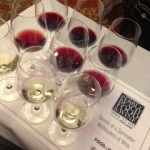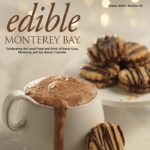By Kurt Foeller
 There is a shroud of mystery that follows the title Master Sommelier. There are only 200 of these individuals working today—the expert’s expert on wine production, storage and service.
There is a shroud of mystery that follows the title Master Sommelier. There are only 200 of these individuals working today—the expert’s expert on wine production, storage and service.
So at the recent Pebble Beach Food & Wine festival, I pounced on the opportunity to see three Master Sommeliers in action, conducting a blind tasting for a group of 100 attendees. Sure, it was fun to watch them blind-taste a set of Chardonnays, Pinot Noirs and Cabernets and then guess at which country they were from, what sub region, and about huch they should cost in a retail shop.
There was no stumping the sommelier, by the way. It was like watching a magic show, watching them reason through their sensations to come up with an answer that always impressed the crowd.
Others may also find it magical how much a Master Sommelier knows about Château Lafite Rothschild and other wines that cost more than $1,000 per bottle on a restaurant list. But that means little to someone like me who rarely spends $50 retail on a single bottle, and more likely $18.
So when the Master Sommelier panel opened up for questions, I asked the one that I thought was most useful for normal wine enthusiasts with normal budgets: what industry secrets or tips do you have to help the everyday wine drinker pick the best wines for a given budget?
Here is what they said:
Secret #1: Get off the grid
Shayn Bjornholm is a Master Sommelier and Education Director for the Court of Master Sommeliers. He encourages wine lovers to go off the grid when looking for quality, bargain wines. Choose wines you’ve never heard of, but from the same grapes and region of wines you know. He also stated the importance of experimentation, noting that people shouldn’t be afraid to try many different wines. Bjornholm’s final recommendation was this: Riesling. This grape is often overlooked by U.S. consumers, but according to Bjornholm, “There is no better $20 value than a Kabinett-style Riesling from the Mosel Region.”
Secret #2: Find a great retailer
Larry O’Brien, Master Sommelier at Kendall Jackson Wines, says to not underestimate the value of a great wine retailer. Good retailers should carry a variety of brands, grapes, and price points and be knowledgeable about the wines they carry. In addition, shop around and find a retailer that demonstrates concern for helping you find a wine you’ll enjoy, rather than the bottle with the highest markup. O’Brien also encourages wine drinkers to forget any pre-conceived notions like, “I don’t like Merlot.” Start with an open mind and be adventurous with recommendations from your retailer. You may be surprised by what you really enjoy.
Secret#3: Study geography
Seventh grade geography gave you a solid grasp on the world map, but you likely have no concept of the many regions within each country. Ray Isle, Executive Editor of Food & Wine, suggests a bit of research can help you shop smarter. Spend some time discovering the satellite regions adjacent to those with larger acclaim. For example, there is a road in the Southern Rhone in France that divides Côtes du Rhône vineyards from Châteauneuf-du-Pape AOC. These satellite regions often share the same soil and produce grapes of equal caliber. Premium regions have premium land prices and consumers pay for it in the bottle.
This is all sage advice—which I’ve already put to work with great success. Walking out of the Pebble Beach Food & Wine event, I realized that I haven’t fully tapped the wine resource that is the sommelier. I’ve held perhaps too tightly my first encounter with one in a restaurant 20 years ago, which didn’t go that well. But today’s wine service professionals are markedly different, as proven by three Master Sommeliers at the top of their game. So next time you’re at a restaurant, I’d recommend spending less time pouring through the wine list and and ask for a consultation with the sommelier or wine steward. You’ll likely be surprised and inspired by the experience.
About the author
At Edible Monterey Bay, our mission is to celebrate the local food culture of Santa Cruz, San Benito and Monterey Counties, season by season. We believe in sustainability, and we believe everyone has a right to healthful, clean and affordable food. We think knowing where our food comes from is powerful, and we hope our magazine, website and newsletters inspire readers to get to know and support our local growers, fishers, chefs, vintners and food artisans.
- Edible Monterey Bayhttps://www.ediblemontereybay.com/author/ediblemontereybay/
- Edible Monterey Bayhttps://www.ediblemontereybay.com/author/ediblemontereybay/
- Edible Monterey Bayhttps://www.ediblemontereybay.com/author/ediblemontereybay/
- Edible Monterey Bayhttps://www.ediblemontereybay.com/author/ediblemontereybay/



